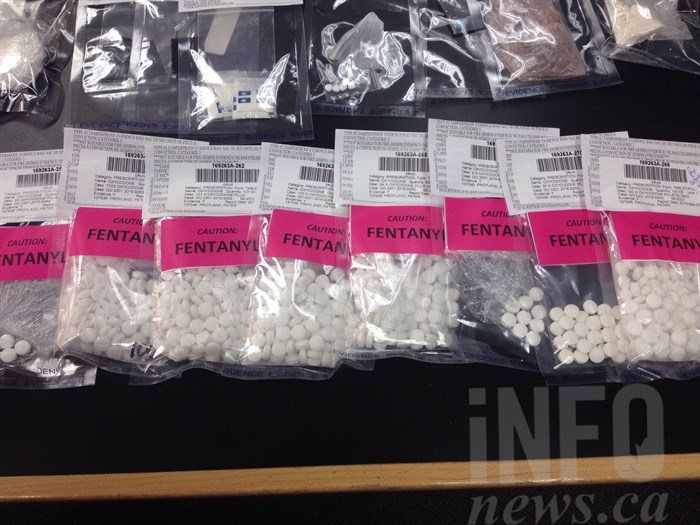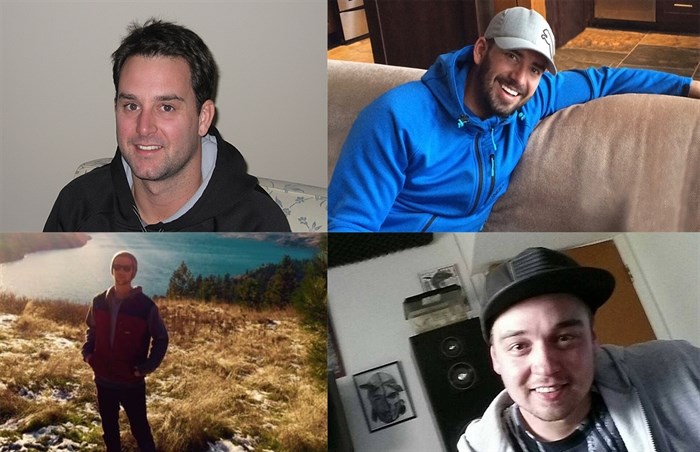
(ASHLEY LEGASSIC / iNFOnews.ca)
December 31, 2016 - 10:30 AM
THOMPSON-OKANAGAN - More than 700 people in B.C. have died this year from illicit drug overdoses, many of which can be attributed to fentanyl, making the drug crisis one of the most talked about issues in the province.
Many of those deaths happened in the Thompson-Okanagan, sparking countless memorials, pushes for naloxone training and even the first cases of fentanyl dealers being sentenced. We were on this story from the beginning.
FENTANYL BEFORE THE COURTS
Kamloops man Matthew Hickson was sentenced this year for dealing fentanyl. He'll spend more than two years in prison but the judge noted it wasn’t confirmed Hickson knew he was actually handling the powerful opioid.
Anthony James Graham was arrested in Kelowna after attempting to flee police. He was found with an abundance of drugs, including 34 grams of fentanyl, 96 grams of crystal meth, 98 grams of crack cocaine and 48 grams of powdered cocaine. Graham was sentenced to three years in prison.
A West Kelowna couple faced charges after an RCMP raid of a warehouse led to the discovery of the production of fentanyl-laced pills. Leslie John McCulloch and Rebekka Rae White were charged with production and possession of a controlled substance.
A Vernon man is heading to trial next year after being charged with two counts of possession for the purpose of trafficking. Sheldon Donald Lee Veness was allegedly caught dealing cocaine and fentanyl and was arrested this past August.

Tyler Leinweber (top left), Adam Pouliot (top right), Ryan Pinneo (bottom left) and Tyler Laybolt (bottom right) all died from fentanyl overdoses in 2016.
(ASHLEY LEGASSIC / iNFOnews.ca)
REMEMBERING THOSE LOST TO FENTANYL
A Kelowna man who died from what was believed to be a heroin overdose was actually taking pure fentanyl. A toxicology report for 40-year-old Tyler Leinweber showed he died from a lethal dose of fentanyl. The father became addicted to pain medications after being prescribed OxyContin, which stemmed into a heroin addiction, or so he thought. The day Leinweber died, he had bought heroin from his dealer which turned out to be pure fentanyl, according to his family.
Adam Pouliot, a 26-year-old Vernon man, had purchased cocaine one night this summer, but it turned out to be laced with fentanyl and it was enough to kill him. His parents spoke out after his death, saying if they had been made aware of the potentially life-saving drug naloxone, they could have spoken to Pouliot about it.
A Kamloops spoken-word artist and musician paid tribute to a friend earlier this year, who fatally overdosed on fentanyl. Ryan Pinneo, 22, died early this year after struggling with an addiction to OxyContin. A coroner’s report revealed the last drug Pinneo took was a lethal dose of fentanyl. Pinneo’s friend Timo Sargent composed a song in his memory, and Pinneo’s mother spoke out about the dangers of fentanyl after her son’s death.
Kamloops rapper Tyler Laybolt, also known as Guck, died in early November after an overdose linked to fentanyl. His friend, local producer Phil Roy, decided to pay tribute to Laybolt and help support the man’s son by committing to finishing Laybolt’s album. Roy is hoping to raise $10,000 for Laybolt’s son.
These are just a few of the faces who represent the ongoing fentanyl crisis in B.C. This year alone, at least 755 people in the province have died from illicit drug overdoses, more than half of which can be attributed to fentanyl.
The B.C. Coroners Service released new numbers last month, which show a more than 70 per cent increase in drug fatalities over the same period last year. Fentanyl was present in about 60 per cent of the cases. In the Interior Health Authority, there were 126 illicit drug overdose deaths from January to November of this year, compared to 63 in 2015. There are no signs of the crisis slowing, as November showed the most drug overdose fatalities in one month, despite new harm-reduction measures introduced this year.
HOW IT STARTED AND HOW FAR WE HAVE COME
In April, provincial officials declared a public health emergency after a surge in overdose deaths. Health Minister and Kamloops MLA Terry Lake was joined by Chief Medical Officer Dr. Perry Kendall in April to make the announcement. It was the first-ever use of the emergency power under the Public Health Act.
The crisis goes further than our province, with record overdose deaths hitting Alberta. But police in Calgary said earlier this year they believed they knew where fentanyl in their province was coming from – Kelowna. Calgary Police Services estimated in March that Kelowna fentanyl re-processing facilities were shipping as many as 100,000 pills per month until being dismantled by Kelowna RCMP.
The Interior Health Authority issued a warning to Kamloops drug users in August, after five drug overdoses in 48 hours, including one fatality. It wasn’t confirmed that fentanyl was behind the spike, but the overdoses were linked to a “sparkly white powder” believed to be sold as cocaine.
Emails between medical health officers discussing the fentanyl crisis were made public earlier this year, with some pointing fingers at the enhanced prohibition of opiates as a factor in the drug's spread. Executive medical director for B.C. Centre for Disease Control, Dr. Mark Tyndall, said in an email he believed the spike in overdose deaths could be attributed to the discontinuation of OxyContin in 2012, blaming physicians who over-prescribe opiates and scaling up on supply which he said has resulted in the import of more concentrated ingredients resulting in high concentrated fentanyl-based pills and powder.
The Interior Health Authority has recently approved overdose prevention sites in Kamloops and Kelowna and there have been conversations around implementing supervised consumption sites in both cities.

Staff members of the Blue Grotto nightclub practice injecting naloxone into a lemon.
(ASHLEY LEGASSIC / iNFOnews.ca)
WHAT CITIZENS HAVE DONE TO HELP
Pharmacists in Kamloops spoke out earlier this year about the need for free naloxone kits, not just for addicts but for anyone who feels they need it. Naloxone is a powerful drug used when someone is thought to be overdosing on an opioid. It can help block the overdose temporarily until medical help arrives.
Pharmacists Cory Proctor and Kristina Gifford said in September that they avoided selling naloxone kits unless it was absolutely necessary. They believed people should not have to pay $40 to $50 for a life saving drug, so they would try to direct people to emergency departments or methadone clinics where naloxone is given to addicts for free.
A Kamloops mother who lost her son to a fentanyl overdose in 2015 called for action earlier this year when she asked downtown businesses to begin carrying naloxone kits. Sandy Kraft said downtown is a high-risk area where some days several people may overdose. Her son Daryl Berry was 20 years old when he overdosed on fentanyl while working in Fort St. John.
Kraft’s story, along with the death of a Kamloops man after a fentanyl overdose at a Kelowna wedding, pushed a nightclub in downtown Kamloops to get equipped with naloxone. The Blue Grotto Nightclub in downtown Kamloops teamed up with ASK Wellness to learn how to administer it in October.
The naloxone program expanded across the Southern Interior this year, with more than 70 new sites being able to administer the drug. All Interior Health emergency departments, public health centres, mental health and substance use offices as well as some community agencies have been equipped with a naloxone kit as part of the Interior Health Authority overdose emergency response.
Kelowna’s Gospel Mission also got naloxone this year, and in the first half of 2016 staff members administered the drug 24 times. At least two of the Mission’s clients are suspected to have died from fentanyl overdoses this year.
A Vernon city councillor spoke out in September saying police, bylaw officers and first responders should carry naloxone kits. Coun. Bob Spiers said police, bylaw officers and first responders should carry the kits not only for the public protection, but for themselves in case they are exposed to fentanyl.
To contact a reporter for this story, email Ashley Legassic or call 250-319-7494 or email the editor. You can also submit photos, videos or news tips to the newsroom and be entered to win a monthly prize draw.
?We welcome your comments and opinions on our stories but play nice. We won't censor or delete comments unless they contain off-topic statements or links, unnecessary vulgarity, false facts, spam or obviously fake profiles. If you have any concerns about what you see in comments, email the editor in the link above.
News from © iNFOnews, 2016